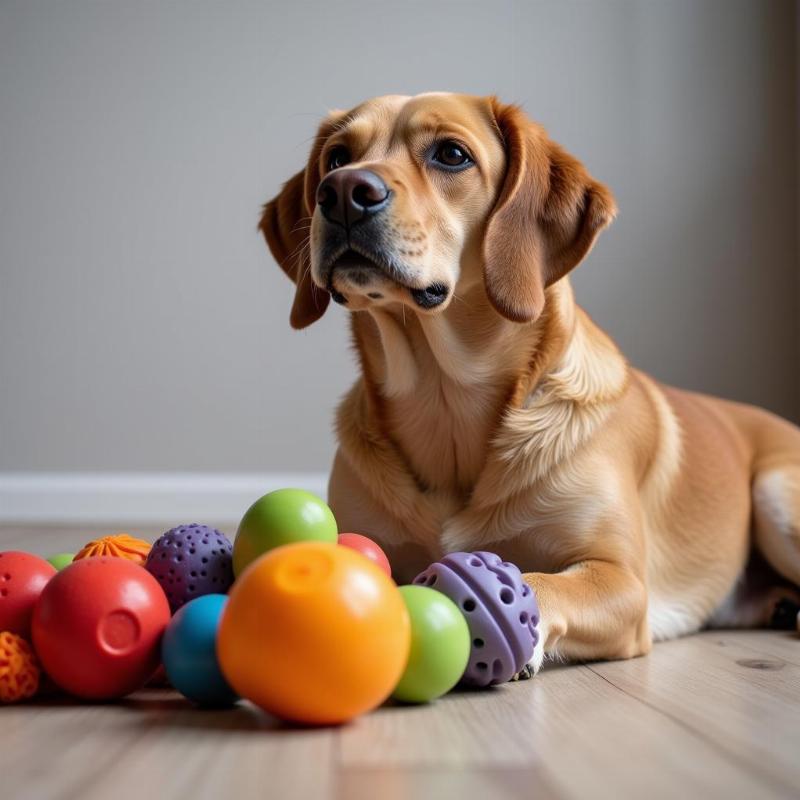Does your furry friend turn up their nose at every squeaky toy, plush animal, or colorful rope you offer? My dog doesn’t play with toys either, and it can be frustrating for owners eager to engage their pups in stimulating play. But rest assured, this isn’t always a cause for concern. This article explores the various reasons why some dogs show disinterest in toys and offers practical tips to help you spark their playful spirit.
Understanding Why Your Dog Doesn’t Play With Toys
There are several reasons why your dog might not be interested in toys. Some breeds are naturally less playful than others. Age is another factor; senior dogs may have less energy for vigorous play. Your dog’s personality also plays a role; some dogs are simply more laid-back and content with cuddles and naps. Past negative experiences, like being punished while playing with a toy, can also create an aversion. Finally, medical conditions, such as arthritis, can make playing painful and therefore unappealing.
 Dog Not Playing With Toys – Bored Dog
Dog Not Playing With Toys – Bored Dog
How to Encourage Your Dog to Play With Toys
Don’t give up! Even the most toy-averse dog can learn to enjoy playtime. Start by finding the right type of toy. Experiment with different textures, sounds, and sizes. Some dogs prefer soft plush toys, while others love the challenge of a durable chew toy. Food-motivated dogs might respond well to puzzle toys filled with treats. Introduce new toys gradually and make them exciting by associating them with positive reinforcement, like praise and treats.
Making Playtime Fun and Engaging
Make playtime interactive! Engage your dog in a game of fetch or tug-of-war. Use high-pitched, enthusiastic tones to pique their interest. Try rotating toys to keep things fresh and prevent boredom. Short, frequent play sessions are often more effective than long ones, especially for puppies or senior dogs.
When to Consult a Veterinarian
If your dog’s sudden disinterest in toys is accompanied by other changes in behavior, such as lethargy, loss of appetite, or whining, consult your veterinarian. These could be signs of an underlying medical condition requiring attention. dog doesn’t play with toys
Addressing Underlying Anxiety or Fear
Sometimes, a dog’s lack of interest in toys stems from anxiety or fear. If you suspect this is the case, work on creating a safe and comfortable environment for your dog. Consult a certified dog trainer or behaviorist for professional guidance on addressing these issues. They can help you identify the root cause of the anxiety and develop a tailored behavior modification plan.
Conclusion: Finding the Joy in Play
While a dog who doesn’t play with toys can be puzzling, with patience and understanding, you can often unlock their inner playfulness. Remember to consider your dog’s breed, age, personality, and any potential medical conditions. By experimenting with different toys and making playtime a positive and engaging experience, you can help your dog discover the joy of play and strengthen your bond. putting your dog down on a good day
FAQ
- Is it normal for a dog not to play with toys? Yes, it can be normal for some dogs to show little interest in toys, especially if they are senior, have a laid-back personality, or have had negative experiences in the past. rainbow city humane society dogs for adoption
- What kind of toys should I try if my dog doesn’t play with anything? Experiment with different textures, sounds, and sizes. Consider puzzle toys for food-motivated dogs, soft plush toys for cuddlers, and durable chew toys for chewers.
- How can I make playtime more engaging for my dog? Make it interactive! Play games like fetch or tug-of-war. Use enthusiastic tones and body language. Rotate toys to keep things fresh. can i take my dog to india from usa
- When should I be concerned about my dog’s lack of interest in toys? If the disinterest is sudden and accompanied by other behavioral changes, such as lethargy, loss of appetite, or whining, consult your veterinarian.
- What if my dog is afraid of toys? Create a safe and comfortable environment. Introduce toys gradually and associate them with positive reinforcement. Consider consulting a certified dog trainer or behaviorist for professional guidance. island dog rescue virginia beach
- How long should I play with my dog each day? Short, frequent play sessions are often more effective than long ones. Aim for 15-30 minutes of playtime, broken up throughout the day.
- Can I force my dog to play with toys? No, forcing your dog to play can be counterproductive and create negative associations with toys. Focus on making playtime a positive and enjoyable experience for your dog.
Beautdogs.us is your premier resource for all things dog-related in the USA. We offer expert advice on dog breeds, care, and the latest products to enhance your furry friend’s life. Whether you’re a new dog owner or a seasoned pro, Beautdogs.us is your trusted source for comprehensive and engaging information. Contact us today for personalized guidance on your dog’s specific needs! Email: [email protected], Phone: +1 501-555-7529. Visit Beautdogs.us for more helpful tips and resources!